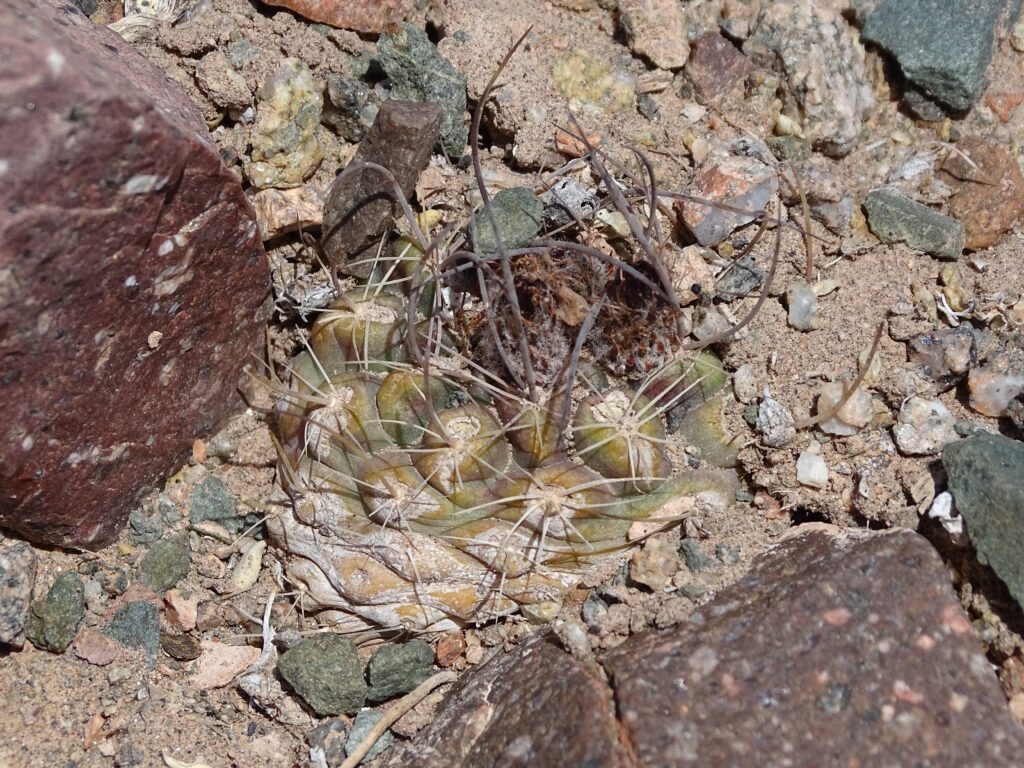

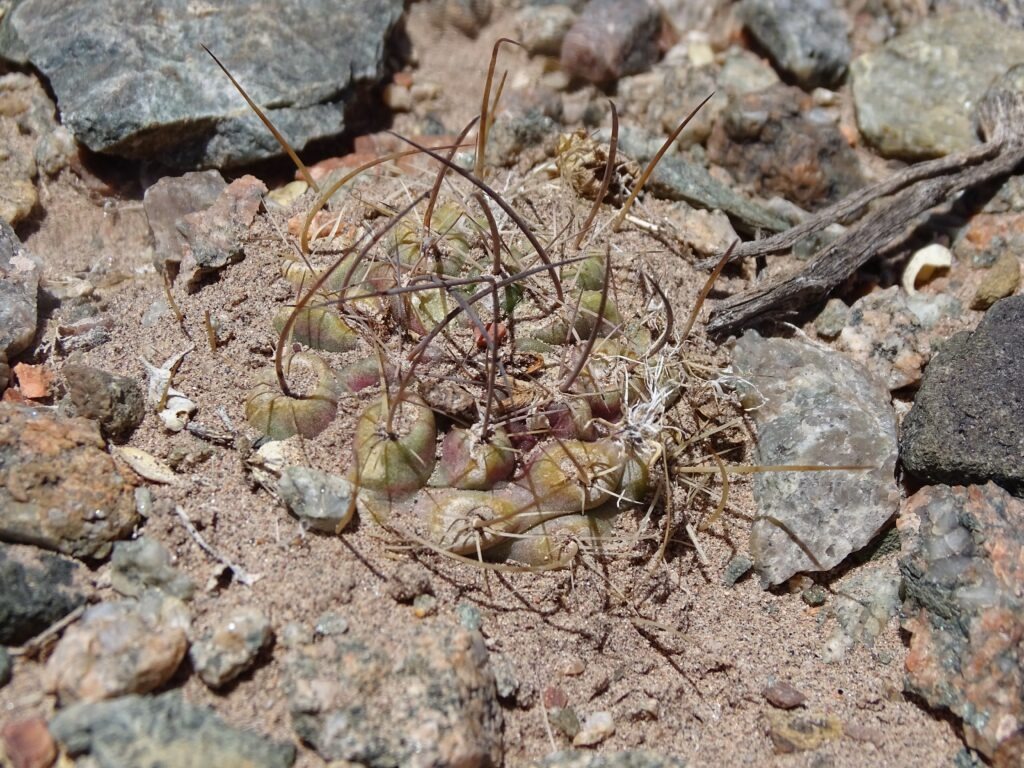

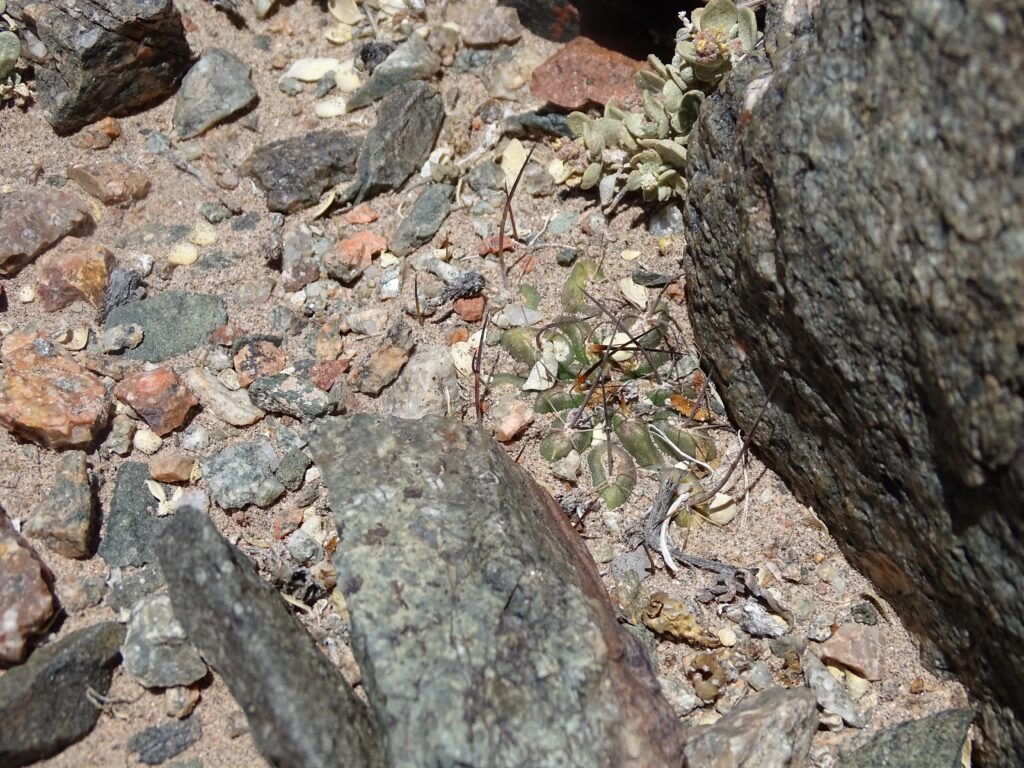
Pyrrhocactus lichyi G.F.Matuszewski & P.Kupčák species nova Rumi Ryan Catamarca Argentina
A new cactus from Argentina is described. Photos as indicated.
Some plants of this new species were first found by the Czech cactus enthusiast Peter Lichy during his trip to Chile and Argentina in February 2016. Driving from Copiapó to Fiambalá, he stopped at many places while exploring the area. There was one location between Paso de San Antonio and Fiambalá where he found some spines and plant tops sticking out of the ground (Fig. 1). He collected a few fruits with seeds in them, from which he managed to get some sturdy seedlings. He grafted some of them onto Pereskiopsis, and once the grafted plants had bloomed and set fruit cleistogamously (within the closed flowers), he considered them to be a new species. The plant I received from Petr Kupčák, grafted on Pereskiopsis, behaved even more unusually. Like some Opuntia, the fruits proliferate from the axils of the scales with further flowers, which also turn into seed-filled fruits (Fig. 3). However, I think this is not a permanent feature as it has not been observed in nature, but is probably caused by a strongly growing rootstock. Only a year later there were fewer flowers.
Pyrrhocactus lichyi Matusz. & Kupčák sp. nov. Differs from Pyrrhocactus andreaeanus by having
a flat-spherical body sunk into the ground, fewer ribs, areoles with a clear trace of the fruit, fewer
central and lateral spines, and small, tubular flowers with a diameter of 10mm, which are cleistogamous.
(See table below.)
Type: Argentina, Catamarca, near Fiambalá, 3,070m, February 2023. Chvastek, Jaroslav CH2779, Slaba,
Rudolf, Sochurek, Miroslav, Maloch, Rostislav. (Holotype: MERL 65319).
Description
Body, solitary, flat-spherical, buried in the ground, only the top and spines protrude from the ground.Epidermis pale-green with red-brown coating. The shoot turns into a thickened root. Ribs, usually 11 divided into large papillae arranged in 5:8 spirals. Areoles round, 2mm in diameter, slightly recessed. At the top of the areole, a round scar remains from the fruit. Central spines 1–2, 4cm long, bent upwards, initially yellow-red with a black top, later greying, with an onion-like thickened base. Lateral spines 6–7(8) arranged radially, in the lower half of the areole, white with a darker tip, length approx. 10mm. Flowers open around noon, tubular 8mm in diameter, 18–23mm long, corolla 10mm in diameter when fully open. Inner petals yellow with a red midstripe, outer petals red-brown. Pericarp and flower tube covered with triangular scales. Seed chamber diameter 3mm. Anthers yellow, only slightly exceeding the pistil. The pistil is 6mm long and 1mm in diameter, light yellow with 7 white stigmas 2.5mm long. Fruits up to 15mm in diameter, up to 20mm long, which dry up by cracking transversely at the base. Seeds 1.1–1.7×0.9–1.2 mm black and brown with brown discolouration, similar to Pyrrhocactus andreaeanus. Hilum 0.5×0.9mm. Micropyle inside the hilum.
Etymology
The epithet commemorates the name of the discoverer, Peter Lichy.
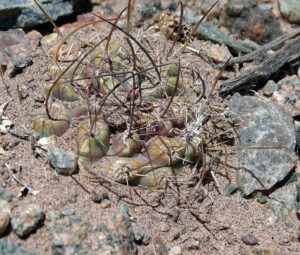
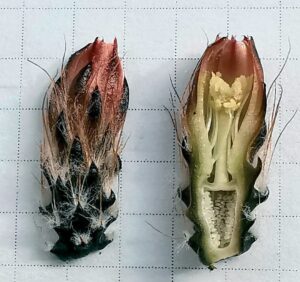
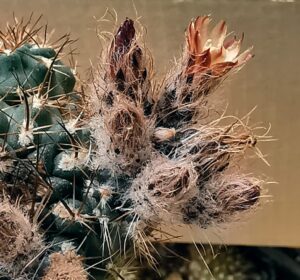
Conservation status
Seedlings flower at a diameter of 15mm. We believe that during the evolution of this species, due to the small number of pollinating insects, it developed cleistogamy as a method of reproduction. Despite this, only a very small number of plants can be found at the site and this species should be classified as endangered and requiring protection.
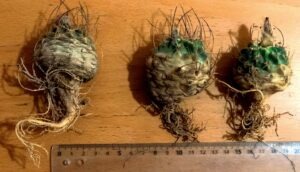
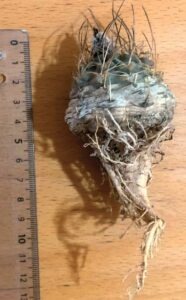

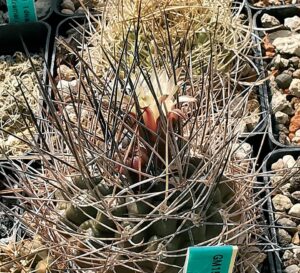
Discussion
We conducted a comparative study of many cacti, and found that the closest were Pyrrhocactus andreaeanus (Backeb.) F.Ritter and Neowerdermannia chilensis Backeb. There are some similarities to N. chilensis in body structure, spines, and flowers, but N. chilensis flowers have a larger crown diameter and open wider in full sun (Fig. 7). However, the flower tube and pericarp of Pyrrhocactus lichyi are covered with bristles (Fig. 2), which is distinctly different from Neowerdermannia, while this is a typical feature of the genus Pyrrhocactus. Also the seeds are similar in shape, size, and surface structure to both compared species (Figs. 8–10), but they are closer to Pyrrhocactus andreaeanus. Thiele (2013) noted that Neowerdermannia chilensis is often self-fertile (although this has never happened in my collection).
The location of Pyrrhocactus lichyi is more than 1,000km away from Neowerdermannia chilensis, while Pyrrhocactus andreaeanus is less than 150km away. The regions on the border of Chile and Argentina above 3,000m are little studied, and plants such as Pyrrhocactus lichyi, which appears similar to Neowerdermannia vorwerkii, are found in places with a substrate that allows it to hide in the ground in periods unfavourable for development. Both are difficult to find. Thus, P. lichyi has characteristics common to one or the other and indeed both genera (Neowerdermannia and Pyrrhocactus). However, this similarity to Neowerdermannia chilensis is probably the result of convergence in adaptation to the ecosystem (similar altitude above sea level, climatic conditions, pollinators, etc.)
We choose the genus Pyrrhocactus because of the characteristics of the flowers and fruits. Only future DNA tests can show whether it deserves recognition as a valid genus. The genus Eriosyce Phil. is a huge ‘sack’ into which many earlier genera have been thrown. According to the research of Guerrero et al (2019) the genus Eriosyce was divided into seven sections, including the section Pyrrhocactus (A.Berger) P.C.Guerrero & Helmut Walter. We believe that these sections should be regarded as genera, and we therefore describe the new plant as a Pyrrhocactus.
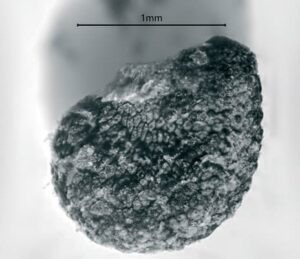
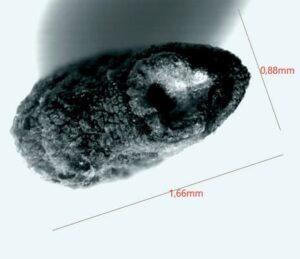
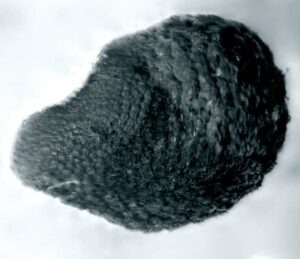
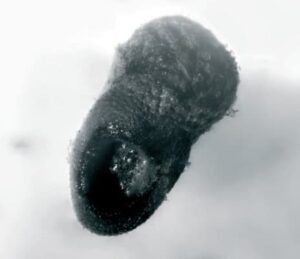
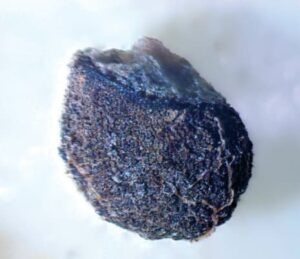
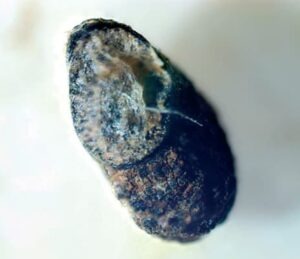
| Pyrrhocactus andreaeanus (Backeb.) F.Ritter | Pyrrhocactus lichyi sp. nov. | |
| Body | Single, cylindrical up to 15cm high and 5cm in diameter, grey-green | Single, flat-spherical, buried in the ground, 5–7cm in diameter, light green with red-brown discolouration |
| Ribs | 14 ribs, 6mm high and approximately 1cm wide | 8–11, twisted, divided into blunt tubercles |
| Areoles | White, oval, 3–4mm wide and 6–7mm long, 10–12mm apart | White, initially 2mm in diameter, slightly recessed, later 2–3mm wide and 7mm long with a trace of fruit left in the upper part, 10–12mm apart |
| Lateral spines | 12, up to approximately 1cm long, white-grey | 5–7 (8), 1cm long, white with a dark tip |
| Central spines | 4, of which 1 longer, up to 1.9–2.2cm long, initially brown with a red thickened base, later grey, flexible | 1–2, 4cm long, yellow-red with a black tip, bent upwards, later turning grey |
| Flowers | 3 cm long, 3.7cm in diameter; tube 1.6cm long with numerous pointed scales, short curly wool, and brown bristles; crown sepals ± linear, up to 2cm long and 2–3mm wide, copper-red with a yellowish edge; greenish-white receptacle; pistil pinkish yellowish white, stigmas white | Tubular flowers 8mm in diameter, 18–23mm long, corolla 10mm in diameter when fully opened. Inner petals yellow with a red central stripe, outer petals red-brown. Pericarp and flower tube covered with triangular scales and setae. Seed chamber diameter 3mm and height 4–5mm. Yellow anthers only slightly exceed the pistil. The pistil is 6mm long and 1mm in diameter, light yellow with 7 patchy white stigmas 2.5mm long |
| Fruit | Reddish, 12mm in diameter, 15mm long, dry by splitting transversely at the base | Green with reddish discolouration, 10–15mm in diameter, 15–20mm long, dry by splitting transversely at the base |
| Seeds | 1.2×1.8mm, black and brown. Oval hilum 0.4×0.6mm. Micropyle inside the hilum | 1.1–1.7×0.9–1.2mm black and brown with brown discolouration. Hilum 0.5×0.7mm. Micropyle inside the hilum |
ACKNOWLEDGEMENTS:
We thank Professor Roberto Kiesling for help, tips and arranging the plants at the herbarium, and our colleague, the Czech collector Jaroslav Chvastek, for his help in collecting and delivering botanical material to the herbarium.
LITERATURE:
Guerrero, P C, Walter, H E, Arroyo, M T K, Peña, C M, Tamburrino, I, De Benedictis,
M, Larridon, I (2013) Molecular phylogeny of the large South American genus Eriosyce
(Notocacteae, Cactaceae): Generic delimitation and proposed changes in infrageneric and
species ranks. Taxon 68(3): 557–573.
Thiele, H (2013) Een paar overdenkingen bij het geslacht Neowerdermannia. Succulenta 92(1): 30–34.


